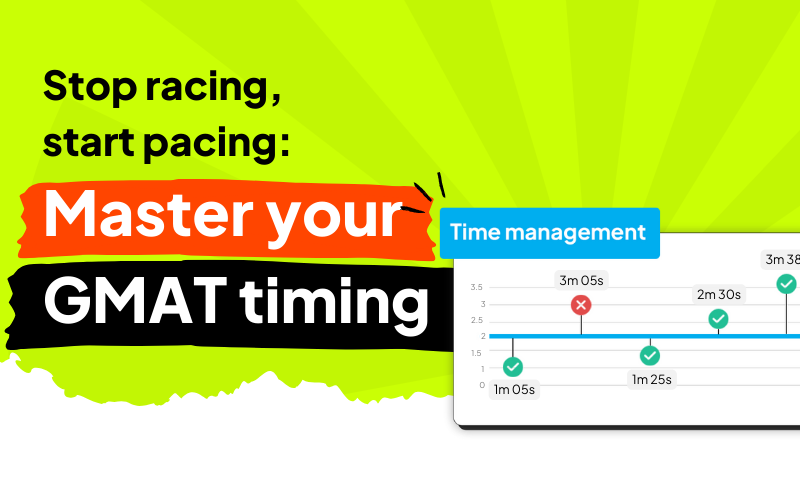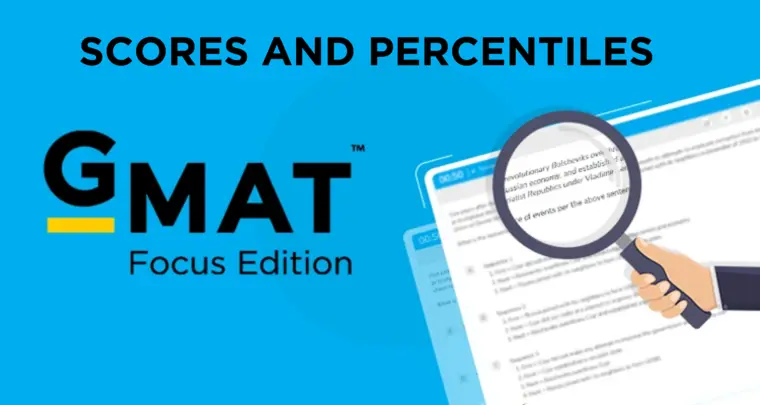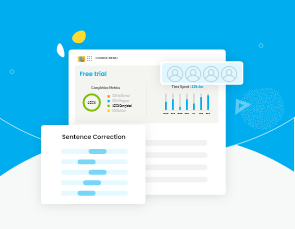“I need to solve every question faster!”
If that thought keeps you up at night while preparing for GMAT Focus, you’re not alone. But here’s the thing – blindly trying to speed up across all questions is like trying to drive at the same speed on highways and city roads. It just doesn’t work.
In my last article, I busted the myth of the “2-minute rule” and introduced you to Takt Time – your personal efficiency metric. I showed you how even Q90 scorers have different solving speeds for different question types.
Today, I’m going deeper. I’m going to show you how to improve your scientific solving speed. Not by rushing through questions or cutting corners but by understanding exactly what’s slowing you down and fixing it strategically.
But first, let’s be clear about what I’m NOT going to do:
- I won’t give you arbitrary time targets to chase
- I won’t tell you to “just solve faster”
- I won’t ask you to compromise on accuracy
Instead, I’ll show you a proven framework that’s helped hundreds of students optimize their speed while maintaining (or even improving) their accuracy.
Ready to master your Takt Time? Let’s dive in. Understanding Your Optimal Time: The TAKT Time Approach
Before we dive into improvement strategies, let’s take a moment to understand what Takt Time really is. Even if you read my previous article, this refresher will set us up for what’s coming next.
1. 1 What is Takt Time?
Borrowed from manufacturing processes, where Taktzeit (German for cycle time) represents the optimal time needed for production, in GMAT preparation, Takt Time means the average time you need to solve questions correctly. But here’s the crucial part: it’s not a one-size-fits-all measure.

In this image, you can see how the Takt time is calculated and how it is unique to each sub-section.
1.2 Why is Takt Time Important?
Think of Takt Time as your personal efficiency metric. It matters because it’s:
- Personalized – just as every runner has their optimal pace, your Takt Time is your current optimal speed for each question type. It reflects your strengths and methods, evolving as you improve.
- Performance-Based – It focuses only on questions you solve correctly. After all, speed without accuracy doesn’t help your GMAT score.
- Question-Specific – Different question types need different amounts of time. Your Takt Time helps you understand where to invest more time and where you can move faster.
1.3 How to Calculate Your Takt Time
Takt time is the average time taken to get a question right. The formula is simple:

Note that you will have different takt times for questions from different sub-sections. For eg, your takt time for DS might be 1.5 min, and for GITA, 3 min.
1.4 Why is Takt Time Important?
Knowing your Takt Time can mean the difference between a good score and a great one. Here’s why:
- It Prevents Score Drops: Consider this: A student who typically scores in the 80th percentile in Verbal when spending 1:30 per question might drop to the 40th percentile when rushing to 1:10. Those 20 seconds saved per question could cost you 40 percentile points!
- It Helps Avoid Time Traps: Without knowing your Takt Time, you might:
- Spend too much time early in the section, forcing a rush at the end
- Leave questions unanswered – as we know, leaving questions unanswered carries a severe penalty.
- Make careless mistakes trying to maintain an arbitrary pace
2 How to reduce Takt Time?
Do you think your Takt Time is higher? Feel your solving process could be more efficient? Let’s say you’re spending over 2.5 minutes consistently on CR/DS questions – while this isn’t necessarily bad (remember, there’s no “ideal” time!), you might want to analyze if there’s room for optimization. But a word of caution – focus on process improvement only if you see clear patterns of inefficiency in your solving approach. We have worked with hundreds of students in optimizing their Takt Times and have perfected a 4-step approach!

This image is the evidence of the 4-step approach! You can see how by applying this strategy, this student was able to bring down their Takt Time for hard questions in CR by 36 seconds – during the test, I can vouch for the fact that this is HUGE!
So, what is this approach, and how do you apply this?
2.1 Identify the Time-Consuming Step Track where you’re spending the most time:

Track where you’re spending the most time:
- Reading a question multiple times: Are you going back to the question repeatedly? This usually means you’re not applying fundamental reading principles – reading passively, without a clear focus, or not looking for key elements that matter for that question type. The way you read needs to match the question type you’re tackling.
- Solution process roadblocks: Each question type has multiple solving steps, and any one of these could be your time sink:
- In Word Problems: Taking too long to translate English to Math
- In CR: Spending excessive time on argument analysis because you cannot visualize.
- In DS: Getting stuck on statement manipulation – lack of skill.
- In RC: Slow passage mapping or question-passage linking.
- Getting trapped in lengthy calculations when shortcuts exist
- Answer choice analysis paralysis: Comparing each option repeatedly or getting stuck between choices.
- Process breaks leading to back-and-forth solving: You might start solving, realize you missed something, go back to the question, and then have to restart your solution. These breaks in process flow are major time drains.
2.2 Diagnose the Root Cause:

Use an error log to understand:
- Comprehension issues: This is fundamental – if you don’t understand what you’re reading, how can you solve it? But here’s the key: is it really a comprehension problem, or are you just not focused while reading? If you consistently need multiple reads to grasp the question, something’s off in your reading approach.
- Concept understanding gaps: When you hit a question and think “Where do I even start?” or spend time trying different approaches hoping one works – that’s a concept gap. You’re taking longer because you’re not sure of the underlying principles needed to solve.
- Process application gaps: Here’s where it gets interesting – you know your concepts, but something in your approach is making you take longer. Your solutions might be correct, but they’re not efficient.
- Lack of practice with specific question types: Your extra time isn’t due to understanding or process issues – you’re just rusty with these question types. The delay comes from having to recall and rebuild your solving approach.
2.3 Take Corrective Action:

- Return to concept files if fundamentals need strengthening: If you identified concept gaps, don’t skip this step hoping practice alone will help. Go back to your basics, understand the underlying principles, and build that strong foundation you need.
- Review application files if your process needs work: When your process isn’t optimal, studying application files shows you the most efficient solving approaches. You’ll see patterns for tackling similar questions and learn structured problem-solving methods.
- Practice similar questions focusing on the identified weak step: Whether it’s comprehension, concept application, or getting back in touch with certain question types – targeted practice is key. Focus on questions that specifically address your diagnosed issue.
2.4 Validate Your Improvement
- Take a timed 10-question quiz using reliable GMAT-like questions: This isn’t just any practice – use questions that match GMAT standards. A focused set of 10 questions gives you enough data to spot patterns without overwhelming your analysis.
- Focus on the specific question type you’re working on: Don’t mix different types of questions yet. If you’re working on Critical Reasoning timing, stick to CR questions for this validation quiz.
- Compare your new Takt Time with your baseline: Remember that Takt Time calculation we discussed? Use it here to see if your solving efficiency has improved. But don’t just look at time – patterns matter more than pure numbers.
- Ensure accuracy isn’t compromised for speed: A faster Takt Time means nothing if your accuracy drops. The goal is efficiency, not just speed. Your success metric should be: solving correctly in less time.
Remember: The goal is efficient solving, not just faster solving.
3 Common Pitfalls to Avoid
While using Takt Time for time management is powerful, there are some common mistakes that can undermine your GMAT Focus score. Here’s what to avoid:
The “Type-Based Skipping” Trap
Don’t pre-decide to skip certain question types (like “I’ll skip all TPA questions”). Why? That “difficult” TPA might actually be an easy question. By blindly skipping it, you’re not only missing a potential correct answer but also sending the wrong signal to the algorithm about your abilities.
The “Fixed Pattern” Mistake
Some test-takers decide to skip every nth question to manage time. This rigid approach ignores question difficulty and your personal Takt Time patterns. A better approach? Let your Takt Time guide your decisions – skip based on your actual solving pace, not an arbitrary pattern.
The “Classic GMAT” Mindset
Remember how GMAT Classic demanded aggressive time management early on because initial questions were medium difficulty? GMAT Focus works differently. Your second section might start with harder questions based on your first section performance. Your timing strategy needs to adapt accordingly.
The Bottom Line
Instead of falling for these traps, stick to your Takt Time-based strategy. Keep it written down, stay flexible based on question difficulty, and let your personal solving patterns guide your decisions.
4 TLDR: Key Takeaways
Takt Time isn’t about hitting some “ideal” solving speed. It’s about understanding and optimizing your personal solving patterns.
The Four-Step Framework:
- Identify where you’re spending excessive time
- Diagnose the real root cause
- Take targeted corrective action
- Validate improvement without compromising accuracy
Remember:
- Every question type might need different solving times from you
- Improvement comes from fixing process inefficiencies, not rushing
- Accuracy should never be sacrificed for speed
Avoid Common Traps:
- Don’t pre-decide to skip specific question types
- Don’t follow rigid skipping patterns
- Don’t stick to outdated timing strategies
Your Next Steps:
- Pick one question type where you feel your solving could be more efficient
- Apply the framework we discussed
5 Taking Action: Your Next Steps
You now understand why rigid time management doesn’t work in GMAT Focus and how Takt Time can be your strategic advantage. Ready to put this into practice?
Your Action Plan:
- Start Tracking – Calculate your Takt Time for different question types in your next practice session. Remember – focus only on questions you get right.
- Test Your Strategy -Take a mock test using your Takt Time insights. Compare your performance with previous attempts where you used fixed timing.
- Refine Your Approach
- Is your Takt Time too high for certain question types?
- Are you successfully banking time from stronger areas?
- How effective is your skipping strategy?
Remember: The GMAT rewards smart preparation, not just hard work. Your success depends not on following generic advice, but on understanding and leveraging your personal solving patterns.
Please let us know in the comments how this strategy pans out for you. All the best.















